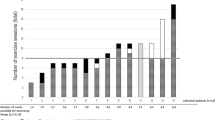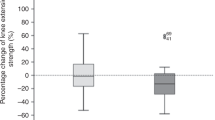Abstract
A haematopoietic SCT (HSCT) can cause severe side effects, which may have a profound impact on a patient's life both physically and psychologically. Some studies have shown that physical activity has positive effects for inpatients after an HSCT. Therefore, the question arises whether a controlled exercise programme right from the beginning of the conditioning phase could help contribute to a patient's physical and psychological recovery. To evaluate the different effects of specific, moderate physical activities on the physical and psychological condition of HSCT patients we performed a controlled randomized study with 64 inpatients undergoing an allogeneic or autologous HSCT. The patients were randomly assigned to two groups. Although the training group took part in a specific programme of exercise therapy twice a day throughout the entire hospitalization phase, patients in the control group were offered the hospital's standard mobilization programme. The results of this study showed significant differences in favour of the training group regarding strength, endurance, lung function and quality of life. However, further studies are needed to confirm these results.
This is a preview of subscription content, access via your institution
Access options
Subscribe to this journal
Receive 12 print issues and online access
$259.00 per year
only $21.58 per issue
Buy this article
- Purchase on Springer Link
- Instant access to full article PDF
Prices may be subject to local taxes which are calculated during checkout

Similar content being viewed by others
References
Baker F, Denniston M, Zabora JR, Marcellus D . Cancer problems in living and quality of life after bone marrow transplantation. J Clin Psychol Med Settings 2003; 10: 27–34.
Baker F, Zabora J, Polland A, Wingard J . Reintegration after bone marrow transplantation. Cancer Pract 1999; 17: 706–718.
Gratwohl A, Schmid O, Baldomero H, Horisberger B, Urbano-Ispizua A, Accreditation Committee of the European Group for Blood Marrow Transplantation (EBMT). Haematopoietic stem cell transplantation (HSCT) in Europe 2002. Changes in indication and impact of team density. A report of the EBMT activity survey. Bone Marrow Transplant 2004; 34: 855–875.
Ostendorf PC, Schäfer UW, Zander AR . Knochenmarktransplantation. In: Ostendorf PC, Seeber S (eds.). Hämatologie– Onkologie. Urban und Schwarzenberg: München, 1997 pp 222–236.
Somerfield MR, Curbow B, Wingard JR, Baker F, Fogarty LA . Coping with the physical and psychosocial sequelae of bone marrow transplantation among long-term survivors. J Behav Med 1996; 19: 163–184.
Winningham M, Nail L, Burke MB, Brophy L, Cimprich B, Jones LS et al. Fatigue and the cancer experience: the state of the knowledge. Oncol Nurs Forum 1994; 21: 23–36.
Bartsch HH, Mumm A, Dellbrück H, Orth HB . Rehabilitation von Patienten nach allogener hämatologischer Stammzelltransplantation. Onkologie 2000; 6: 44–51.
Broers S, Kaptein AA, Le Cessie S, Fibbe W, Hengeveld MW . Psychological functioning and quality of life following bone marrow transplantation: a 3-year follow-up study. J Psychosom Res 2000; 48: 11–21.
Fife BL, Huster GA, Cornetta KG, Kennedy VN, Akard LP, Broun ER . Longitudinal study of adaptation to the stress of bone marrow transplantation. J Clin Oncol 2000; 18: 1539–1549.
McQuellon RP, Russell GB, Rambo TD, Craven BL, Radford J, Perry JJ et al. Quality of life and psychological distress of bone marrow transplant recipients: the ‘time trajectory’ to recovery over the first year. Bone Marrow Transplant 1998; 21: 477–486.
Zittoun R, Achard S, Ruszniewski M . Assessment of quality of life during intensive chemotherapy or bone marrow transplantation. Psychooncology 1999; 8: 64–73.
Dimeo F, Fetscher S, Lange W, Mertelsmann R, Keul J . Effects of aerobic exercise on the physical performance and incidence of treatment-related complications after high-dose chemotherapy. Blood 1997; 90: 3390–3394.
Schüle K . Zum Stellenwert der Sport- und Bewegungstherapie bei Patientinnen mit Brust- oder Unterleibskrebs. Rehabilitation 1983; 22: 36–39.
Dimeo F, Thimm S, Fetscher S, Mertelsmann R, Keul J . Aerobes Training nach Knochenmark- und peripherer Stammzelltransplantation. In: Bartsch H, Mertelsmann R (eds). Knochenmark- und periphere Stammzelltransplantation Medizinische Probleme der Posttransplantationsphase und Rehabilitationsstrategien. Karger-Verlag: Freiburg, 1996; pp 66–71.
Mock V, Burke MB, Sheehan P, Creaton EM, Winningham ML, McKenney-Tedder S et al. A nursing rehabilitation program for women with breast cancer receiving adjuvant chemotherapy. Oncol Nurs Forum 1994; 21: 899–907.
Peters C, Lötzerich H, Niemeier B, Schüle K, Uhlenbruck G . Influence of a moderate exercise training on a natural killer cytotoxicity and personality traits in cancer patients. Anticancer Res 1994; 14: 1033–1036.
Andrykowski MA, Henslee PJ, Barnett RL . Longitudinal assessment of adult survivors of allogenic bone marrow transplantation. Bone Marrow Transplant 1989; 4: 505–509.
Cunningham BA, Morris G, Cheney CL, Buergel N, Aker SN, Lenssen P . Effects of resistive exercise on skeletal muscle in marrow transplant recipients receiving total parenteral nutrition. J Parenter Enteral Nutr 1986; 10: 558–563.
Coleman EA, Coon S, Hall-Barrow J, Richards K, Gayler D, Stewart B . Feasibility of exercise during treatment for multiple myeloma. Cancer Nurs 2003; 26: 410–419.
Coleman EA, Hall-Barrow J, Coon S, Stewart CB . Facilitating exercise adherence for patients with multiple myeloma. Clin J Oncol Nurs 2003; 7: 529–534.
Dimeo F, Bertz H, Finke J, Fetscher S, Mertelsmann R, Keul J . An aerobic exercise program for patients with haematological malignancies after bone marrow transplantation. Bone Marrow Transplant 1996; 18: 1157–1160.
Hayes SC, Rowbottom D, Davies PS, Parker TW, Bashford J . Immunological changes after cancer treatment and participation in an exercise program. Med Sci Sports Exerc 2003; 35: 2–9.
Willenbacher W, Mumm A, Rüther A, Weis J, Bartsch HH . Somatic risk factors for intermediate and long-term sequelae after haematological stem cell therapy predictive for feasibility of a rehabilitation program. Onkologie 1998; 21: 217–223.
Mello M, Tanaka C, Dulley FL . Effects of an exercise program on muscle performance in patients undergoing allogeneic bone marrow transplantation. Bone Marrow Transplant 2003; 32: 723–728.
Kim SD, Kim HS . A series of bed exercises to improve lymphocyte count in allogeneic bone marrow transplantation patients. Eur J Cancer Care 2006; 15: 453–457.
Yano K, Kanie T, Okamoto S, Kojima H, Yoshida T, Maruta I et al. Quality of life in adult patients after stem cell transplantation. Int J Hematol 2000; 71: 283–289.
Hjermstad M, Holte H, Evensen S, Fayers P, Kaasa S . Do patients who are treated with stem cell transplantation have a health-related quality of life comparable to the general population after 1 year? Bone Marrow Transplant 1999; 24: 911–918.
Watson M, Wheatley K, Harrison GA, Zittoun R, Gray RG, Goldstone AH et al. Severe adverse impact on sexual functioning and fertility of bone marrow transplantation, either allogeneic or autologous, compared with consolidation chemotherapy alone: analysis of the MRC AML 10 trial. Cancer 1999; 86: 1231–1239.
Kopp M, Schweigkofler H, Holzner B, Nachbaur D, Niederwieser D, Fleischhacker WW et al. Time after bone marrow transplantation as an important variable for quality of life: results of a cross-sectional investigation using two different instruments for quality-of-life assessment. Ann Hematol 1998; 77: 27–32.
Courneya KS, Keats MR, Turner AR . Physical exercise the quality of life in cancer patients following high dose chemotherapy autologous bone marrow transplantation. Psychooncology 2000; 9: 127–136.
WHO. Exercise Tests in Relation to Cardiovascular Function, Technic Report Series No. 338. Geneva, 1968.
Riesenberg H . In-patient rehabilitation of lung cancer patients –predictors and outcome. Tumordiagn u Ther 2007; 28: 279–284.
Herrero F, San Juan AF, Fleck SJ, Foster C, Lucia A . Effects of detraining on the functional capacity of previously trained breast cancer survivors. Int J Sports Med 2007; 28: 257–264.
Takata Y, Ansai T, Akifusa S, Soh I, Yoshitake Y, Kimura Y et al. Physical fitness and 4-year mortality in an 80-year-old population. J Gerontol A Biol Sci Med Sci 2007; 62: 851–858.
Benhamou D, Cuvelier A, Muir JF . Prévention des infections transmises par les traitements par CPAP et ventilation non invasive. Rev Pneumol Clin 2001; 57: 73–78.
Schneider CM, Hsieh CC, Sprod LK, Carter SD, Hayward R . Exercise training manages cardiopulmonary function and fatigue during and following cancer treatment in male cancer survivors. Integr Cancer Ther 2007; 6: 235–241.
Aaronson NK, Ahmedzai S, Bergman B, Bullinger M, Cull A, Duez NJ et al. The European Organization for Research and Treatment of Cancer QLQ-C30: a quality-of-life instrument for use in international clinical trials in oncology. J Natl Cancer Inst 1993; 85: 365–376.
Hayden PJ, Keogh F, Ni Conghaile M, Carrol M, Fitzsimon N, Gardiner N et al. A single-centre assessment of long-term quality-of-life status after sibling allogneic stem cell transplantation for chronic myeloid leukaemia in first chronic phase. Bone Marrow Transplant 2004; 34: 545–556.
Hjermstad MJ, Evensen SA, Kvaløy SO, Loge JH, Fayers PM, Kaasa S . The CARES-SF used for prospective assessment of health-related quality of life after stem cell transplantation. Psychooncology 2003; 12: 803–813.
Hensel M, Egerer G, Schneeweiss A, Goldschmidt H, Ho AD . Quality of life and rehabilitation in social and professional life after autologous stem cell transplantation. Ann Oncol 2002; 13: 209–217.
Hacker ED, Ferrans CE . Quality of life immediately after peripheral blood stem cell transplantation. Cancer Nurs 2003; 26: 312–322.
Dimeo F, Stieglitz RD, Novelli-Fischer U, Fetscher S, Keul J . Effects of physical activity on the fatigue and psychologic status of cancer patients during chemotherapy. Cancer 1999; 85: 2273–2277.
Dimeo FC, Tilmann MH, Bertz H, Kanz L, Mertelsmann R, Keul J . Aerobic exercise in the rehabilitation of the cancer patients after high dose chemotherapy and autologous peripheral stem cell transplantation. Cancer 1997; 79: 1717–1722.
Bastian K . Körperliches Training mit COPD-Patienten–Funktionelle und psychologische Aspekte. Deutsche Sporthochschule Köln, Dissertation 2002.
Rost R, Lagerstrøm D, Völker K . Die Fahrradergometrie und körperliches Training bei Herz-Kreislauf-Patienten. Echo Verlags-GmbH: Köln, 1996.
Hollmann W, Hettinger T . Sportmedizin Grundlagen für Arbeit, Training und Präventivmedizin. Schattauer Verlagsgesellschaft: Stuttgart, 2000.
Apolone G, Filiberti A, Cifani S, Ruggiata R, Mosconi P . Evaluation of the EORTC QLQ-C 30 questionnaire A comparison with SF-36 Health Survey in a cohort of Italian long-survival cancer patients. Ann Oncol 1998; 9: 549–557.
Acknowledgements
This study was supported by the German José Carreras Leukemia Foundation, Munich, Germany, the Stefan Morsch Foundation, Birkenfeld, Germany and the Förderverein Transplantationszentrum Idar-Oberstein e. V., Idar-Oberstein, Germany.
Author information
Authors and Affiliations
Corresponding author
Rights and permissions
About this article
Cite this article
Baumann, F., Kraut, L., Schüle, K. et al. A controlled randomized study examining the effects of exercise therapy on patients undergoing haematopoietic stem cell transplantation. Bone Marrow Transplant 45, 355–362 (2010). https://doi.org/10.1038/bmt.2009.163
Received:
Revised:
Accepted:
Published:
Issue Date:
DOI: https://doi.org/10.1038/bmt.2009.163
Keywords
This article is cited by
-
Effects of pulmonary rehabilitation in hematopoietic stem cell transplantation recipients: a randomized controlled study
Supportive Care in Cancer (2024)
-
A scoping review of studies exploring physical activity and cognition among persons with cancer
Journal of Cancer Survivorship (2023)
-
Exercise in allogeneic bone marrow transplantation: a qualitative representation of the patient perspective
Supportive Care in Cancer (2022)
-
Krebsprävention – die Rolle der körperlichen Bewegung vor und nach einer Krebserkrankung
Forum (2022)
-
Evaluation of indices for predicting recovery of exercise tolerance in patients surviving allogenic hematopoietic stem cell transplantation
Supportive Care in Cancer (2022)



